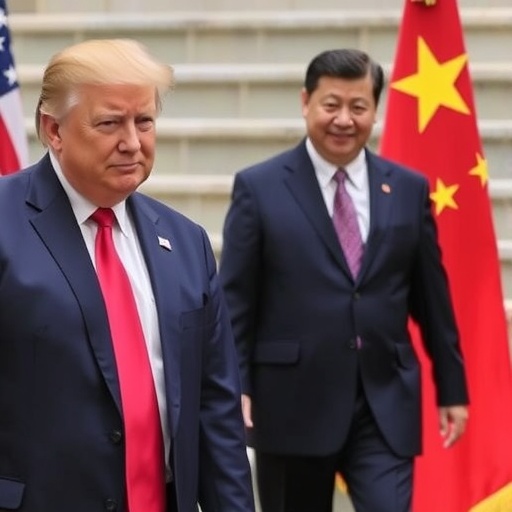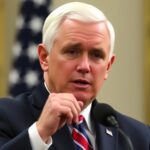In a dramatic pivot that could redefine global economics, Presidents Donald Trump and Xi Jinping are preparing to seal a sweeping US-China trade deal, sources close to the negotiations reveal. This breakthrough comes after months of tit-for-tat tariffs and escalating rhetoric, offering a potential lifeline to strained international relations between the world’s two largest economies.
The agreement, expected to be finalized at an upcoming summit, addresses long-standing grievances over intellectual property theft, market access, and unfair trade practices. White House officials confirmed late Wednesday that high-level talks have accelerated, with U.S. Trade Representative Robert Lighthizer and Chinese Vice Premier Liu He leading marathon sessions. ‘We’re on the cusp of something historic,’ a senior administration source told reporters, emphasizing the deal’s potential to boost U.S. exports by billions while curbing China’s aggressive industrial policies.
This development marks a significant thaw in US-China trade dynamics, which have been battered by over $360 billion in mutual tariffs since 2018. The pact could unlock $200 billion in Chinese purchases of American goods, from soybeans to semiconductors, analysts estimate. As Trump touts his ‘America First’ agenda, Xi Jinping faces domestic pressures to stabilize China’s export-driven growth amid a slowing economy.
Breakthrough Negotiations: From Tariffs to Truce
The path to this US-China trade deal has been anything but smooth. What began as Trump’s 2018 imposition of 25% tariffs on $50 billion of Chinese imports—targeting steel, aluminum, and tech components—spiraled into a full-blown trade war. China retaliated with duties on U.S. agricultural products, hitting American farmers hard and prompting $28 billion in federal aid. By mid-2019, global supply chains were disrupted, with the International Monetary Fund warning of a 0.8% drag on worldwide GDP.
Recent momentum shifted during secret backchannel talks in Geneva last month, where envoys from both sides hashed out compromises. ‘The stars are aligning for a phase-one agreement,’ said Peter Navarro, Trump’s trade advisor, in a Fox News interview. Key concessions include China’s pledge to increase imports of U.S. energy and farm goods by 40% over two years, potentially injecting $77 billion into rural economies. In return, the U.S. has agreed to suspend further escalations on auto tariffs, a move that could save Detroit automakers up to $10 billion annually.
International relations experts view this as a pragmatic reset. ‘Trump’s unpredictable style forced Xi to the table,’ noted Elizabeth Economy, a senior fellow at the Council on Foreign Relations. ‘But the real test will be enforcement—China’s history of vague commitments raises red flags.’ Data from the U.S. Census Bureau shows the trade deficit with China peaked at $419 billion in 2018, fueling Trump’s campaign promises. Now, with elections looming, this deal could be a political win, shoring up support in swing states like Iowa and Ohio.
Core Pillars of the Sweeping US-China Trade Agreement
At the heart of this emerging trade deal lies a multifaceted framework designed to balance economic interests. Intellectual property protection stands out as a cornerstone, with China committing to stricter enforcement against forced technology transfers—a practice long criticized by U.S. firms like Apple and Qualcomm. Under the terms, Beijing will establish a new IP tribunal and impose penalties up to 5% of a company’s revenue for violations, according to draft documents leaked to Bloomberg.
Agriculture emerges as another winner, with China vowing to lift quotas on U.S. poultry and beef imports, addressing a market previously dominated by Brazilian suppliers. The American Farm Bureau Federation estimates this could add $14 billion to U.S. exports, revitalizing Midwest heartlands battered by prior retaliatory tariffs. On the industrial front, the deal phases out subsidies for Chinese state-owned enterprises in sectors like steel and solar panels, aiming to level the playing field for American manufacturers.
Financial services also see gains, as China opens its $40 trillion banking sector to more U.S. investment. Firms like JPMorgan Chase stand to benefit, with projections from Goldman Sachs indicating a 15% uptick in cross-border capital flows. ‘This isn’t just trade—it’s about trust,’ Xi Jinping stated during a recent speech at the World Economic Forum, underscoring Beijing’s willingness to ’embrace fair competition.’ Trump echoed this sentiment on Twitter, posting: ‘Great progress with China! Billions for our farmers and workers. Winning!’
Yet, the agreement isn’t without caveats. It defers thornier issues like currency manipulation—where the U.S. Treasury has accused China of undervaluing the yuan by 10-15%—to future phases. Economists from the Peterson Institute for International Economics warn that without robust dispute resolution, the deal risks unraveling, much like the 2001 WTO entry promises that fell short.
Global Markets React to US-China Trade Thaw
News of the impending trade deal sent shockwaves through financial markets, with the Dow Jones Industrial Average surging 2.5% on Thursday, its best day in months. Tech stocks, particularly those exposed to China like Boeing and Caterpillar, jumped 4-6%, reflecting optimism over reduced supply chain risks. In Asia, the Shanghai Composite Index climbed 1.8%, while currency traders bet on a stronger U.S. dollar against the yuan.
Analysts are bullish on the broader implications for international relations. ‘This deal could stabilize the global trading system,’ said Ian Bremmer, president of Eurasia Group, in a CNBC appearance. ‘It signals that even adversaries can find common ground amid pandemic recovery.’ The World Trade Organization, long sidelined by U.S.-China disputes, hailed the progress, noting it might prevent further fragmentation of multilateral rules.
However, not all reactions are positive. European leaders, wary of being sidelined, expressed concerns over potential U.S. favoritism. German Chancellor Angela Merkel commented, ‘A balanced US-China trade pact is welcome, but it must not undermine WTO principles.’ In developing nations, there’s apprehension about redirected Chinese exports flooding markets; India’s commerce ministry is already preparing countermeasures against a possible influx of subsidized goods.
From a macroeconomic lens, the deal could add 0.5% to U.S. GDP growth by 2022, per Moody’s Analytics forecasts, while easing inflationary pressures from tariffs. For China, facing 6.1% growth in 2019—its slowest in decades—this accord provides breathing room, potentially averting job losses in export hubs like Guangdong province.
Challenges Ahead: Enforcing the US-China Trade Deal
While the framework excites stakeholders, enforcement remains the Achilles’ heel of this US-China trade deal. Historical precedents, such as China’s partial compliance with 2015 IP reforms, breed skepticism. U.S. officials are pushing for a bilateral oversight committee with snap audits, but Beijing resists, preferring domestic courts. ‘Verification is key—without it, this is just paper promises,’ warned Senate Finance Committee Chairman Chuck Grassley in a statement.
Geopolitical tensions complicate matters. Ongoing issues like Huawei’s 5G dominance and U.S. restrictions on TikTok underscore deeper rifts in international relations. Trump has linked trade progress to human rights concerns in Xinjiang, adding a layer of complexity that could derail finalization. Chinese state media, via Xinhua, countered that ‘economic cooperation should not be politicized,’ highlighting Xi Jinping’s focus on decoupling trade from security.
Domestic politics on both sides pose hurdles. In the U.S., progressive Democrats like Elizabeth Warren demand stronger labor standards, fearing the deal exploits Chinese workers. Trump’s base, including steelworkers in Pennsylvania, wants ironclad protections against dumping. In China, nationalists decry concessions as weakening sovereignty, pressuring Xi to maintain a firm stance.
Experts suggest phased implementation: starting with verifiable agricultural buys, monitored via satellite crop data and trade logs. The U.S. International Trade Commission projects that full enforcement could resolve 70% of current disputes within three years, but lapses might trigger renewed tariffs, costing $100 billion in lost trade annually.
Future Horizons: Reshaping Global Trade Post-Deal
Looking ahead, the finalization of this US-China trade deal under Trump and Xi Jinping could herald a new era in international relations, fostering multilateral initiatives like a revived Trans-Pacific Partnership. With summits slated for November in Chile or virtually if needed, both leaders aim to ink the pact before year’s end, potentially averting a holiday-season tariff hike.
For businesses, the ripple effects are profound. Supply chains may realign, with Vietnam and Mexico gaining as ‘China-plus-one’ hubs, but U.S. firms could repatriate $500 billion in operations over a decade, per McKinsey estimates. Consumers stand to benefit from lower prices—tariff removals might cut iPhone costs by 10%—while innovation surges through protected IP.
On the world stage, this accord might embolden climate talks, with trade incentives tied to green tech sharing. As Trump eyes legacy and Xi consolidates power, the deal’s success hinges on sustained dialogue. ‘This is just the beginning,’ a State Department official confided. ‘A stable US-China trade relationship could prevent conflicts that reshape the 21st century.’ With stakes this high, the global community watches intently, hopeful for a trade truce that promotes prosperity over confrontation.








